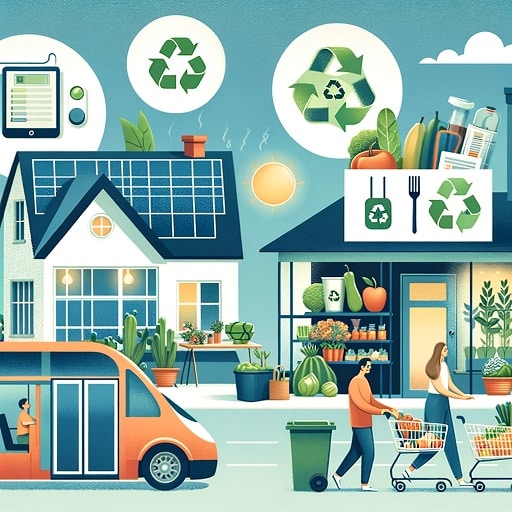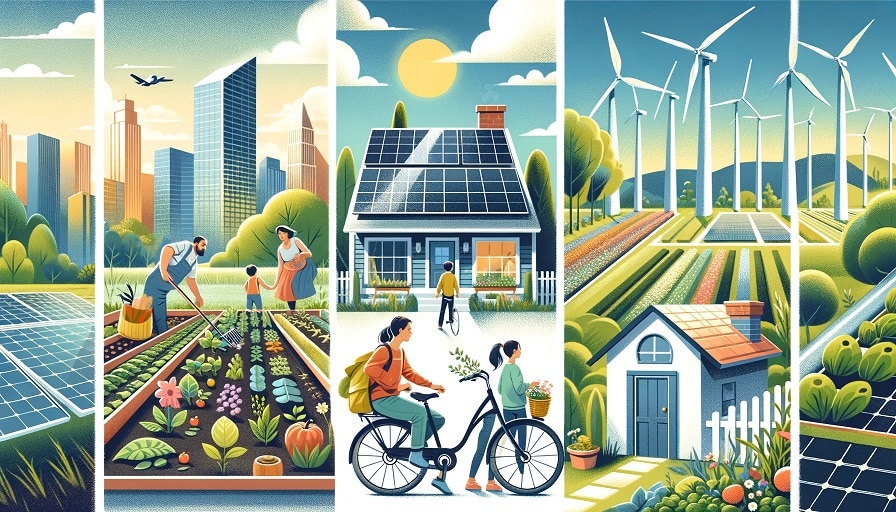Climate change stands as one of the most significant challenges of our time, impacting our planet and the lives of billions. In the face of rising temperatures, erratic weather patterns, and increasing natural disasters, the need for action has never been more urgent. This brings us to sustainable living – a powerful tool in our collective effort to mitigate the effects of climate change.
Summary: How Can Sustainable Living Help Combat Climate Change?
Sustainable living, a lifestyle choice focused on reducing one’s environmental impact, plays a crucial role in combating climate change. By adopting practices that minimize carbon emissions, conserve natural resources, and reduce our overall environmental footprint, individuals and communities can significantly contribute to slowing down the adverse effects of climate change. Embracing a more sustainable lifestyle involves making conscious choices in our day-to-day life – from the energy we use to the products we consume – leading to a reduction in greenhouse gas emissions and a healthier planet for future generations.
Understanding Climate Change

Climate change refers to long-term alterations in temperature, precipitation, and wind patterns on Earth. Primarily driven by human activities, especially the burning of fossil fuels like coal, oil, and natural gas, climate change is causing a significant increase in greenhouse gas emissions, notably carbon dioxide, methane, and nitrous oxide. These gases trap heat in the Earth’s atmosphere, leading to the greenhouse effect, which results in global warming and various climatic disruptions.
The consequences of climate change are far-reaching, affecting everything from the global weather system to sea levels, and impacting both natural and human systems. The rise in average temperatures leads to more frequent and severe weather events like hurricanes, droughts, and floods. Melting polar ice caps and glaciers contribute to rising sea levels, threatening coastal communities. Moreover, climate change affects biodiversity, agriculture, water supply, and even human health, making it a critical global issue that demands immediate attention and action.
The global impacts of climate change are thoroughly assessed by bodies like the Intergovernmental Panel on Climate Change, whose work underscores the urgent need for global action towards sustainability.
The Principles of Sustainable Living

Sustainable living is a comprehensive approach to reducing one’s environmental impact and leading a lifestyle that harmonizes with nature. This philosophy encompasses various aspects of daily life, from energy consumption to waste management, and encourages a shift towards more sustainable practices. Adopting a sustainable lifestyle means making deliberate choices to minimize the use of natural resources, reduce carbon and other greenhouse gas emissions, and prevent environmental degradation.
Key components of a sustainable lifestyle include:
- Energy Efficiency: Utilizing renewable energy sources like solar and wind power, and adopting practices like energy-efficient lighting and appliances to reduce energy consumption.
- Waste Reduction: Embracing a zero waste lifestyle by reducing, reusing, and recycling materials, thereby minimizing the amount of waste sent to landfills.
- Sustainable Transportation: Opting for public transportation, biking, walking, or driving fuel-efficient cars to reduce fossil fuel consumption and carbon emissions.
- Sustainable Food Choices: Favoring organic food, reducing meat consumption, and minimizing food waste contribute significantly to a more sustainable food system.
These principles are not just theoretical but are being practically implemented by organizations like NASA. For example, NASA’s sustainability objectives include increasing energy efficiency and using renewable energy, showcasing how large organizations can adopt these practices.
By incorporating these sustainable practices into our daily lives, we can create a more sustainable life, benefiting not only the environment but also our health and well-being.
How Sustainable Living Can Help Climate Change

Sustainable living is not just a personal choice; it’s a necessary response to the growing concerns of climate change. By adopting sustainable lifestyles, individuals and communities can play a significant role in reducing greenhouse gas emissions and limiting the effects of climate change. Here’s how:
- Reducing Energy Consumption: Shifting towards renewable energy sources like solar and wind power is key. By using less energy or opting for energy-efficient options, we can significantly decrease the demand for fossil fuels, thereby reducing carbon dioxide emissions.
- Minimizing Waste: Adopting a zero waste lifestyle, which includes reducing food waste and using eco-friendly products, can lower the amount of waste that ends up in landfills, thus reducing methane emissions.
- Sustainable Transportation: Using public transportation, cycling, or driving fuel-efficient cars can considerably reduce your carbon footprint. Transportation is a major contributor to greenhouse gas emissions, and by making eco-friendly choices, we help lessen its impact.
- Sustainable Food Choices: The Food and Agriculture Organization highlights the impact of the meat industry on greenhouse gases. Adopting a plant-based diet or reducing meat consumption can significantly lower the environmental impact of our food system.
Individual actions play a critical role in addressing climate change, as highlighted by the United Nations Environment Programme. These efforts collectively contribute to combating the climate crisis.
By integrating these sustainable practices into our daily lives, we not only reduce our carbon footprint but also encourage a larger scale shift towards a more environmentally conscious society.
Benefits of Sustainable Living Beyond Climate Change

The benefits of sustainable living extend far beyond mitigating climate change. These lifestyle choices can also lead to economic savings, healthier living conditions, and a more robust local economy. Here are some key benefits:
- Economic Benefits: Living sustainably can save money in the long run. Using renewable energy sources like solar panels, being energy efficient, and reducing waste can lower household expenses.
- Health Benefits: Improved air quality, both indoors and outdoors, is a direct result of reduced fossil fuel use and increased reliance on renewable energy. This leads to better overall health and a lower incidence of respiratory diseases.
- Community and Social Benefits: Sustainable living fosters a sense of community. Engaging in practices like shopping local, participating in community gardens, and using public transport can strengthen community bonds and support the local economy.
The broader benefits of sustainable living, especially in terms of public health, are emphasized by organizations such as the US Environmental Protection Agency, which focuses on combating climate change while protecting health in vulnerable communities.
Challenges and Misconceptions
While the advantages are clear, there are challenges and misconceptions associated with sustainable living. Some view it as too expensive or difficult to implement. However, with growing awareness and technological advancements, sustainable options are becoming more accessible and affordable. Overcoming these challenges requires education, support from community and government initiatives, and a willingness to embrace change.
Taking Action – Practical Steps Towards Sustainable Living
Embracing a sustainable lifestyle might seem daunting, but there are numerous simple and effective ways to make a difference. Here are some practical steps to start living more sustainably:
- Reduce Energy Use: Save energy by turning off lights and electronics when not in use. Consider installing energy-efficient appliances and solar panels to reduce reliance on fossil fuels.
- Conserve Water: Simple actions like taking shorter showers, fixing leaks, and using water-efficient appliances can significantly conserve water.
- Minimize Waste: Reduce waste by recycling, composting food scraps, and choosing reusable over single-use products. Adopting a zero waste lifestyle can dramatically decrease your environmental footprint.
- Eco-Friendly Transportation: Opt for public transport, carpooling, biking, or walking whenever possible. If you drive, consider a fuel-efficient or electric car.
- Sustainable Food Choices: Choose organic and locally produced foods, reduce meat consumption, and minimize food waste to support a more sustainable food system.
- Support Sustainable Practices: Encourage and support local businesses that follow sustainable practices. This not only helps the environment but also strengthens the local economy.
Conclusion: Sustainable Living and Climate Change
Sustainable living is not just a trend; it’s a necessary shift towards a more responsible and environmentally conscious way of life. By taking small, manageable steps towards a more sustainable lifestyle, we can collectively have a significant impact on reducing our carbon footprint and combating climate change. Each action, no matter how small, contributes to a healthier planet and a better future for generations to come. Let’s embrace the challenge and transform our lives for the greater good.
FAQs
How Can Being Sustainable Help the Environment?
Being sustainable helps the environment by reducing greenhouse gas emissions, conserving natural resources, and minimizing pollution and waste. This leads to a healthier ecosystem and a more stable climate.
What Are Simple Sustainable Practices I Can Start Today?
Simple sustainable practices include conserving energy and water, recycling, using public transportation, and making conscious food choices like reducing meat consumption and minimizing food waste.
Is Sustainable Living More Expensive?
While some sustainable options might have a higher upfront cost, they often lead to long-term savings. Additionally, many sustainable practices, like reducing energy use and minimizing waste, can actually save money.
How Does Sustainable Living Impact Global Warming?
Sustainable living reduces the amount of greenhouse gases released into the atmosphere, which is a major contributor to global warming. By living sustainably, we can help slow down the rate of climate change.

